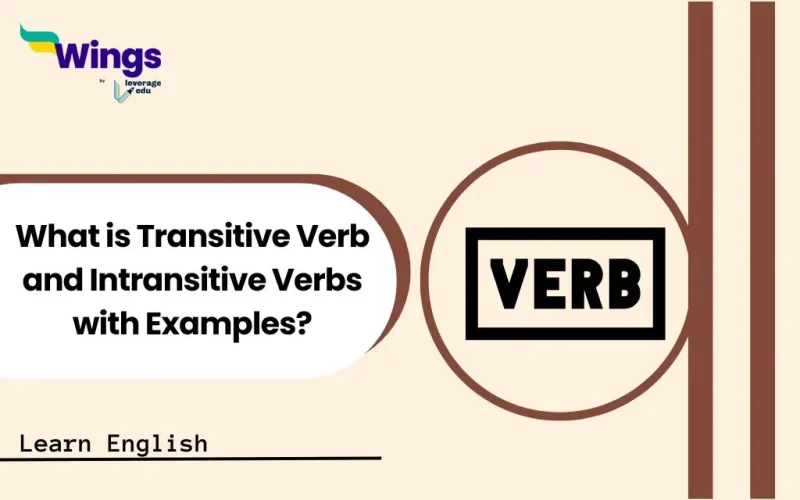Transitive and intransitive verbs play a crucial role in understanding sentence structure and grammar. A transitive verb requires a direct object to complete its meaning, whereas an intransitive verb does not need an object to convey a complete thought. Knowing the difference between these two types of verbs can enhance your writing and communication skills. This blog will explore what is transitive verb and intransitive verbs with examples, helping you master their usage effectively and effortlessly in everyday language.
This Blog Includes:
- What is a Transitive Verb?
- What is an Intransitive Verb?
- 10+ Examples of Transitive and Intransitive Verbs in Sentences
- Key Differences Between Transitive and Intransitive Verbs
- Transitive and Intransitive Verbs Exercises with Answers
- Exercise 1: Identify the Verb Type
- Exercise 2: Fill in the Blanks
- Exercise 3: Underline the Direct Object
- Exercise 4: Rewrite Sentences
- Exercise 5: True or False
- Exercise 1: Identify the Verb Type
- Exercise 2: Fill in the Blanks
- Exercise 3: Rewrite Sentences
- Exercise 4: Match the Sentences
- Exercise 5: True or False
- FAQs
What is a Transitive Verb?
A Transitive Verb is an action verb that requires one or more subjects to complete the meaning. In simple words, a transitive verb transfers its action to a direct object. The presence of a direct object is essential for the sentence to make sense.
Examples to get a better understanding of the definition:
- She kicked the ball.
Kicked is the transitive verb, and the ball is the direct object receiving the action.
- He wrote a letter.
Here, wrote is the transitive verb, and a letter is the direct object.
- They built a house.
In this case, built is the transitive verb, while a house is the direct object.
20 Examples of Transitive Verbs
Here are 20 examples of transitive verbs, each accompanied by a sentence to illustrate their use. These verbs require a direct object to complete their meaning.
| Word | Example Sentence |
| Eat | She eats an apple every morning. |
| Read | She eats an apple every morning. |
| Write | They wrote a letter to their friend. |
| Build | The workers built a new bridge. |
| Give | She gave her brother a birthday present. |
| Send | He sent an email to his colleague. |
| Make | The chef made a delicious cake. |
| Buy | They bought a new car last week. |
| Teach | She teaches her students mathematics. |
| Find | He found his keys under the couch. |
| Show | She showed her artwork at the gallery. |
| Bring | Can you bring me a glass of water? |
| Tell | He told her a funny story. |
| Call | I will call you tomorrow. |
| Choose | They chose the blue paint for the walls. |
| Help | She helped him with his homework. |
| Clean | He cleaned the kitchen after dinner. |
| Paint | They painted the fence bright yellow. |
| Answer | She answered all the questions correctly. |
| Start | He started the project last month. |
How to Identify Transitive Verbs?
When working with intransitive verbs, the following are the things that one must look at:
- Requires a Direct Object: Transitive verbs need a direct object to receive the action. For example, “She reads the book,” the verb “reads” is transitive, and “the book” is the direct object receiving the action of reading.
- Can Have Indirect Objects: Transitive verbs can also take indirect objects, which are the recipients of the direct object. For instance, in “He gave his friend a gift,” “gave” is the transitive verb, “a gift” is the direct object, and “his friend” is the indirect object.
What is an Intransitive Verb?
An intransitive verb, on the other hand, does not require an object to complete its meaning. These verbs express actions or states of being that do not act upon a direct object. Intransitive verbs can stand alone without needing additional information.
20 Examples of Intransitive Verbs
Here are 20 examples of intransitive verbs, each used in a sentence to demonstrate their function.
| Word | Example Sentence |
| Run | She runs every morning to stay fit. |
| Laugh | They laughed at the funny joke. |
| Sleep | He sleeps soundly through the night. |
| Arrive | The train arrives at noon. |
| Cough | She coughed loudly during the meeting. |
| Jump | The cat jumped onto the table. |
| Smile | He smiled when he saw his friend. |
| Cry | The baby cried for hours. |
| Sit | They sat quietly in the corner. |
| Emerge | The sun emerged from behind the clouds. |
| Faint | She fainted from exhaustion. |
| Agree | They agreed on the terms of the contract. |
| Depart | The bus departs at 5 PM. |
| Wait | I will wait until you arrive. |
| Grow | The plants grow quickly in the summer. |
| Dance | They danced joyfully at the celebration. |
| Rest | He rested after a long day at work. |
| Shiver | She shivered in the cold wind. |
| Vanish | The magician made the rabbit vanish. |
| Happen | Unexpected things often happen during travel. |
How to identify Intransitive Verbs?
To identify intransitive verbs in a sentence, the following are the steps that you must follow:
- No Direct Object Needed: Intransitive verbs stand alone and do not require an object to receive the action. For instance, “She runs,” the verb “runs” does not need an object to convey its meaning.
- Can Be Followed by Adverbials: Intransitive verbs can be followed by adverbial modifiers—words or phrases that provide additional information about the action. For example, “He sleeps soundly” provides information about how he sleeps, but does not have a direct object.
Also Read: Transitive and Intransitive Verbs Exercises (Free PDF)
10+ Examples of Transitive and Intransitive Verbs in Sentences
Following are the examples of the Transitive Verbs which will help you with the sentence formation:
Take a look at the examples of intransitive verbs which will be helpful for you:
Also Read: Transitive and Intransitive Verbs Quiz
Key Differences Between Transitive and Intransitive Verbs
Here’s a clear comparison of transitive and intransitive verbs presented in a tabular format:
| Feature | Transitive Verbs | Intransitive Verbs |
| Definition | Verbs that require a direct object to complete their meaning. | Verbs that do not require a direct object; can stand alone. |
| Direct Object Requirement | Requires a direct object to complete the action. | Does not require a direct object to convey meaning. |
| Action Direction | The action is directed from the subject to the object. | The action does not pass on; it is complete without an object. |
| Questions Answered | Answers “What?” or “Whom?” after the verb. | Does not answer these questions; the action stands alone. |
| Passive Voice Usage | Can be used in passive constructions (e.g., “The ball was kicked by her”). | Cannot be used in passive voice; no object to promote to subject. |
| Examples | She kicked the ball. He wrote a letter. They built a house. | He laughed. She sleeps. The sun sets. |
Also Read: Nouns vs Verbs: Difference You Must Know!
Transitive and Intransitive Verbs Exercises with Answers
Here are ten exercises focused on transitive and intransitive verbs, complete with answers to help reinforce understanding.
Transitive Verbs Exercises with Answers
Exercise 1: Identify the Verb Type
Instructions: For each sentence, write T if the verb is transitive and I if the verb is intransitive.
- The dog chased the cat.
- She smiled at the camera.
- He built a sandcastle.
- They travelled to Europe last summer.
- I found my keys on the table.
Answers:
- Transitive Verb (Chased)
- Intransitive Verb (Smiled)
- Transitive Verb (Built)
- Transitive Verb (Travelled)
- Transitive Verb (Found)
Exercise 2: Fill in the Blanks
Instructions: Fill in the blanks with either a transitive or intransitive verb from the list provided.
| *Verbs List: (play, read, sleep, give, sing) |
- The children __________ in the park every afternoon.
- She __________ a book before bed.
- The cat __________ on the windowsill all day.
- He __________ a song beautifully at the concert.
- They __________ their toys after playing.
Answers:
- Play (Intransitive Verb)
- Read (Transitive Verb)
- Sleep (Intransitive Verb)
- Sang (Transitive Verb)
- Gave (Transitive Verb)
Exercise 3: Underline the Direct Object
Instructions: Underline the direct object in each of the following sentences with transitive verbs.
- The teacher explained the lesson clearly.
- She baked a cake for her friend’s birthday.
- They watched a movie last night.
- He wrote a letter to his grandmother.
- The artist painted a mural on the wall.
Answers:
- The teacher explained the lesson clearly.
- She baked a cake for her friend’s birthday.
- They watched a movie last night.
- He wrote a letter to his grandmother.
- The artist painted a mural on the wall.
Exercise 4: Rewrite Sentences
Instructions: Rewrite the following sentences by adding a direct object to make the verbs transitive.
- The dog barked at the stranger.
- She danced a beautiful waltz.
- They spoke their minds openly.
- We walked the dog around the block.
- He jumped over the puddle.
Answers:
- The dog barked at the stranger.
- She danced a beautiful waltz.
- They spoke their minds openly.
- We walked the dog around the block.
- He jumped over the puddle.
Exercise 5: True or False
Instructions: Determine if the following statements are true or false regarding transitive verbs.
- A transitive verb can exist without a direct object.
- All action verbs are transitive.
- A transitive verb must have an object to complete its meaning.
- Intransitive verbs can be used in passive voice.
- Transitive verbs always require two objects.
Answers:
- False
- False
- True
- False
- False
Intransitive Verbs Exercises with Answers
Exercise 1: Identify the Verb Type
Instructions: For each sentence, write I if the verb is intransitive.
- The baby cried loudly.
- She laughed at the joke.
- The sun sets in the west.
- They arrived late to the meeting.
- He slept peacefully through the night.
Answers:
- I (cried)
- I (laughed)
- I (sets)
- I (arrived)
- I (slept)
Exercise 2: Fill in the Blanks
Instructions: Fill in the blanks with appropriate intransitive verbs from the list provided.
| *Verbs List: (run, laugh, sleep, arrive, dance) |
- The children __________ around the playground.
- She __________ when she heard the funny story.
- The train __________ at 10 AM.
- He __________ on the couch all afternoon.
- They __________ gracefully at the recital.
Answers:
- Ran
- Laughed
- Arrived
- Slept
- Danced
Exercise 3: Rewrite Sentences
Instructions: Rewrite the following sentences by changing the verb to an intransitive form.
- The dog barked loudly.
- She finished quickly.
- They played on the beach.
- He wrote beautifully.
- The teacher explained clearly.
Answers:
- The dog barked loudly.
- She finished quickly.
- They played on the beach.
- He wrote beautifully.
- The teacher explained clearly.
Exercise 4: Match the Sentences
Instructions: Match each sentence with its correct verb type.
| Sentence | Verb Type |
| 1. He sleeps soundly | A) Intransitive Verb |
| 2. They danced at the party | B) Intransitive Verb |
| 3. The baby cried | C) Intransitive Verb |
| 4. The sun shines brightly | D) Intransitive Verb |
| 5. Birds fly south for winter | E) Intransitive Verb |
Answers:
1 – A (Intransitive)
2 – B (Intransitive)
3 – C (Intransitive)
4 – D (Intransitive)
5 – E (Intransitive)
Exercise 5: True or False
Instructions: Determine if the following statements are true or false regarding intransitive verbs.
- An intransitive verb requires a direct object.
- Intransitive verbs can stand alone and still make sense.
- All action verbs are intransitive.
- Intransitive verbs can be used in passive voice.
- Intransitive verbs do not require any additional information to convey meaning.
Answers;
- False
- True
- False
- False
- True
Explore more blogs from Learn English!
FAQs
Transitive Verbs are action verbs that require a direct object to complete their meaning. The action is directed towards someone or something.
Example: She kicked the ball. (Here, kicked is transitive, and the ball is the direct object.)
Intransitive Verbs are action verbs that do not require a direct object. They can stand alone and still convey a complete thought.
Example: He laughed. (Here, laughed is intransitive and does not need an object.)
Some examples of transitive verbs are: give, take, make, send, tell, show, buy, find, write and build.
She read the book in one sitting.
He painted the fence last weekend.
They watched a movie together.
I baked cookies for the bake sale.
The teacher explained the lesson clearly.
She gave him a ride to the airport.
He fixed my computer yesterday.
They built a treehouse in their backyard.
I found my keys under the couch.
She taught him how to play guitar.
She laughed loudly at the joke.
The baby cried for hours.
He sleeps soundly every night.
They arrived late to the meeting.
The sun sets in the west.
She danced beautifully at the recital.
The flowers bloomed in spring.
He ran quickly to catch the bus.
They waited patiently for their turn.
The dog barked at the stranger.
We hope this blog on What is Transitive Verb and Intransitive Verbs with Examples was informative and helped you improve your English skills. You can also follow the Learn English page of Leverage Edu for more exciting and informative blogs related to English grammar and the English language.
 One app for all your study abroad needs
One app for all your study abroad needs















 60,000+ students trusted us with their dreams. Take the first step today!
60,000+ students trusted us with their dreams. Take the first step today!

